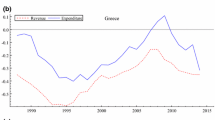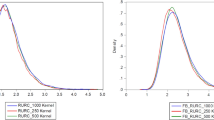Abstract
Threshold cointegration tests have made a big splash in the literature by allowing for asymmetric adjustment in linear cointegration tests. This paper contributes to this literature by proposing new tests to improve the power of the conventional threshold cointegration tests. The new tests intuitively resolve one of the possible reasons that attribute to the low power of existing threshold cointegration tests and are easy to implement since they do not require any additional information outside of the system. Our simulation results show that the proposed tests improve the power of the existing threshold cointegration tests, especially as the signal-to-noise ratio increases, in contrast to other considered procedures. The efficiency gains are achieved regardless of sample size, the number of cointegrated variables, and the types of threshold specifications. The newly developed tests are applied to examine long-run purchasing power parity in the Pacific nations. In contrast to conventional cointegration tests, the proposed tests found long-run PPP holds in 5 out of 7 countries with appropriate asymmetric adjustments.
Similar content being viewed by others
Notes
The lagged terms of \(\Delta x_{1t} \) and \(\Delta x_{2t} \) are omitted to simplify the notation.
To estimate (9), the residual from the long-run regression (1), \(\hat{\mu } _t =x_{1t} -d_t \hat{\gamma }-\hat{\beta }^{{\prime }}x_{2t} \) is employed. Here, replacing \(\gamma \) and \(\beta '\) with their OLS estimate does not affect the distributional properties of the test due to consistency of the OLS estimators. For more details, see the appendix of Lee and Lee (2015).
Note that \(\mathrm{cov}\left( {v_t ,\,\epsilon _t } \right) =k\times \mathrm{cov}\left( {\Delta x_{2t} ,\epsilon _t} \right) +\mathrm{var}\left( {\epsilon _t} \right) \).
Here, \(t_{\mathrm{Max}_s }^*\), and \({\Phi }_s^*\) denotes \(t_{\mathrm{Max}_s }\), \({\Phi }_s \) test statistics obtained based on consistently estimated threshold value \(\tau \).
This is done to ensure a sufficient number of observations in each regime.
In the case of MTAR, the first differenced residual is reordered and considered as a potential threshold value. The remaining procedures are analogous to those of the TAR case.
The results from the model with a constant and trend are similar to that of model with a constant; we provide tables for model with a constant case only throughout the paper. The omitted results are available upon request.
The sizes of \(t-\)Max-based tests \((t_{\mathrm{Max}_s} )\) are around 0.03, and the Ftest-based tests \((\Phi _s )\) show sizes about 0.08. The MTAR case displays similar results.
Here, \(\mathrm{var}\left( {\epsilon _t} \right) =\mathrm{var}\left( {v_t} \right) +k^{2}\mathrm{var}\left( {\Delta x_{2t} } \right) -2\mathrm{cov}\left( {v_t ,\,k\Delta x_{2t} } \right) =\mathrm{var}\left( {v_t } \right) -k^{2}\mathrm{var}\left( {\Delta x_{2t} } \right) \), since \(\mathrm{cov}\left( {v_t ,\,k\Delta x_{2t} } \right) =\mathrm{cov}\left( {k\Delta x_{2t} +\epsilon _t ,\, k\Delta x_{2t} } \right) =2k^{2}\mathrm{var}\left( {\Delta x_{2t} } \right) \) when \(\mathrm{cov}\left( {\epsilon _t ,\,\Delta x_{2t} } \right) =0\).
One might question whether there is any influence on the size and power property of tests as we allow higher-order dynamics in a series. To examine the issue, we have revised \(x_{2t} \) in the DGP (14) to follow an AR(2) process, \(x_{2t} =\lambda _1 x_{2,\,t-1} +\lambda _2 x_{2,\,t-2} +u_{2t} \), and considered two cases: \(\left( {\lambda _1 ,\,\lambda _2 } \right) =\left( {0.9,\,0.1} \right) \) and \(\left( {\lambda _1 ,\,\lambda _2 } \right) =\left( {0.7,\,0.3} \right) \). The size and power properties are similar to the base line cases displayed in Tables 3, 4, 5, 6, and 7: the powers of the tests are mainly affected by the signal-to-noise ratio as the base line cases and the impact of higher-order dynamics in a cointegrating series looks insignificant. To save space, we do not include this output table here; these results are available upon request.
For example, see the case of \((\rho _1 ,\,\,\rho _2) = (-0.025, -0.1), (-0.05, -0.1)\), and \((-0.1, -0.15)\).
For example, see the case of \((\rho _1 ,\,\,\rho _2 ) = (-0.025, -0.2)\) when \(q = 0\).
EC found evidence supporting PPP in five countries, Indonesia, Korea, Malaysia, the Philippines, and Thailand at 1, 1, 1, 10, and 1% significance levels, respectively.
In EC, the data for Korea, Singapore, and Thailand were between 1973:1 and 2001:7, the Philippines data were between 1973:1 and 2001:6, the Malaysia data were between 1973:1 and 2001:4, the Indonesia data were between 1973:1 and 2000:12, and the Hong Kong data were from 1990:1 and 2001:6. However, we used data from 1980:10 to 2015:5.
As requested by an anonymous referee, we also applied the proposed tests to the same period of data as used in the EC paper. The new tests rejected the same five cases of PPP of the same countries and at the same significance level as the EC paper did. As shown in the simulation section, the performance of the modified tests does not always dominate that of ES tests; the efficiency gains are observed as the CFR becomes invalid. It seems the CFR becomes more prominent in the sample periods used in EC than in the extended sample periods used in our paper and this situation is responsible for the similar results in both the ES and the new tests.
References
Bec F, Salem MB, Carrasco M (2004) Tests for unit root versus threshold specification with an application to the purchasing power parity relationship. J Bus Econ Stat 22:382–395
Bec F, Guay A, Guerre E (2008) Adaptive consistent unit-root tests based on auto-regressive threshold model. J Econom 142(1):94–133
Chen LH, Finney M, Lai K (2005) A threshold cointegration analysis of asymmetric price transmission from crude oil to gasoline prices. Econ Lett 89(2):233–239
Cook S (2007) A threshold cointegration test with increased power. Math Comput Simulat 73:386–392
Cook S (2008) Finite-sample power properties of threshold cointegration tests. Appl Econ Lett 15(1):27–30
Enders W, Siklos PL (2001) Cointegration and threshold adjustment. J Bus Econ Stat 19(2):166–176
Enders W, Chumrusphonlert K (2004) Threshold cointegration and purchasing power parity in the Pacific nations. Appl Econ 36:889–896
Engle R, Granger C (1987) Co-integration and error correction: representation, estimation, and testing. Econometrica 55(2):251–276
Ericsson NR, MacKinnon JG (2002) Distributions of error correction tests for cointegration. Econom J 5:285–318
Gouveia P, Rodrigues P (2004) Threshold cointegration and the PPP hypothesis. J Appl Stat 31(1):115–127
Hansen B (1995) Rethinking the univariate approach to unit root testing. Econom Theory 11:1148–1171
Harbo I, Johansen S, Nielsen B, Rahbek A (1998) Asymptotic inference on cointegrating rank in partial systems. J Bus Econ Stat 16(4):388–399
Heimonen K (2006) Nonlinear adjustment in PPP evidence from threshold cointegration. Empir Econ 31(2):479–495
Krishnakumar J, Neto D (2009) Estimation and testing for the cointegration rank in a threshold cointegrated system. Working papers, Econometrics Department, University of Geneva
Kremers JJM, Ericsson NR, Dolado JJ (1992) The power of cointegration tests. Oxford B Econ Stat 54(3):325–348
Lee H, Lee J (2015) More powerful Engle-Granger cointegration tests. J Stat Comput Simul 85(15):3154–3171
Li J, Lee J (2010) ADL tests for threshold cointegration. J Time Ser Anal 31(4):241–254
Lo MC, Zivot E (2001) Threshold cointegration and nonlinear adjustment to the law of one price. Macroecon Dyn 5:533–576
McMillan DG (2005) Threshold adjustment in spot futures metals prices. Applied Financ Lett 1(1):5–8
Million N (2004) Central Bank’s interventions and the Fisher hypothesis: a threshold cointegration investigation. Econ Model 21(6):1051–1064
Siklos P (2002) Asymmetric adjustment from structural booms and slumps. Econ Lett 77(3):329–333
Author information
Authors and Affiliations
Corresponding author
Rights and permissions
About this article
Cite this article
Oh, DY., Lee, H. & Meng, M. More powerful threshold cointegration tests. Empir Econ 54, 887–911 (2018). https://doi.org/10.1007/s00181-017-1243-4
Received:
Accepted:
Published:
Issue Date:
DOI: https://doi.org/10.1007/s00181-017-1243-4




